|


The Australian dollar (sign: $; code: AUD) is the currency of the Commonwealth of Australia, including Christmas Island, Cocos (Keeling) Islands, and Norfolk Island, as well as the independent Pacific Island states of Kiribati, Nauru and Tuvalu. Within Australia it is almost always abbreviated with the dollar sign ($), with A$ or AU$ sometimes used informally to distinguish it from other dollar-denominated currencies. It is subdivided into 100 cents.
The Australian dollar is currently the sixth-most-traded currency in the world foreign exchange markets behind the US dollar, the euro, the yen, the pound sterling, and the Swiss franc, accounting in 2007 for approx. 3.3% of worldwide daily foreign-exchange turnover. The Australian dollar is popular with currency traders due to comparatively high interest rates in Australia, the relative freedom of the foreign exchange market from government intervention, the general stability of Australia's economy and political system, and the prevailing view that the Australian dollar offers diversification benefits in a portfolio containing the major world currencies, especially because of its greater exposure to Asian economies and the commodities cycle.
HISTORY
With pounds, shillings and pence to be replaced by decimal currency in the 1960s, many names for the new currency were suggested. In 1965, the Prime Minister, Robert Menzies, a monarchist, wished to name the currency the royal. Other proposed names included more exotic suggestions such as the austral, the oz, the boomer, the roo, the kanga, the emu, the digger, the kwid, the dinkum, the bloody paper and the ming (Menzies' nickname). Due to Menzies' influence, the name royal was settled on, and trial designs were prepared and printed by the Reserve Bank of Australia. The choice of name for the currency proved unpopular, and it was later dropped in favour of the dollar.
The dollar was introduced on 14 February 1966, replacing the Australian pound (distinct from the pound sterling since 1931) with a decimal currency. The initial rate of conversion was two dollars per pound, or ten shillings per dollar. Its exchange rate was pegged to the sterling at a rate of 1 dollar = 8 shillings (2.50 dollars = 1 pound). In 1967, Australia effectively left the sterling era. When the sterling was devalued in 1967 against the U.S. dollar, the Australian dollar did not follow. It maintained its peg to the U.S. dollar at the same rate of 1 Australian dollar = 1.12 U.S. dollars.
COINS
In 1966, coins were introduced in denominations of 1, 2, 5, 10, 20 and 50 cents. The initial 50 cent coins contained high silver content and were withdrawn after a year for fear that the growing value of the silver content would exceed the intrinsic value of the coins. One-dollar coins were introduced in 1984, followed by two-dollar coins in 1988. The one- and two-cent coins were discontinued in 1991 and withdrawn from circulation. In commemoration of the 40th anniversary of decimal currency, the 2006 mint proof and un-circulated sets included one- and two-cent coins. Cash transactions are rounded to the nearest five cents. As with most public changes to currency systems, there has been a great amount of seignorage of the discontinued coins. All coins portray the head of state, Queen Elizabeth II, on the obverse, and are produced by the Royal Australian Mint.
Australia has regularly issued commemorative 50-cent coins. The first was in 1970, commemorating James Cook's exploration along the east coast of the Australian continent, followed in 1977 by a coin for Queen Elizabeth II's Silver Jubilee, the wedding of Charles, Prince of Wales and Lady Diana Spencer in 1981, the Brisbane Commonwealth Games in 1982, and the Australian Bicentenary in 1988. Issues expanded into greater numbers in the 1990s and the 21st century, responding to collector demand. Australia has also made special issues of 20-cent and one-dollar coins.
The portrait of Queen Elizabeth II on the obverse side has gone through some changes. The first change was when the decimal system was introduced in 1966, the next facelift came in 1985, with a new crown and pose, and finally the most recent in 1999, showing a more age-appropriate portrait of the queen.
There are many five-dollar coins, of aluminum/bronze and bi-metal, and many silver and gold bullion coins in higher denominations. These are not normally used in payment, although they are legal tender.
Current Australian 5-, 10- and 20-cent coins are identical in size to the former Australian, New Zealand and British sixpenny, shilling and two shilling (florin) coins. In 1990, the UK replaced these coins with smaller versions, as did New Zealand in 2006 - at the same time discontinuing the five-cent coin. With a mass of 15.55 grams and a diameter of 31.51 mm, the Australian 50-cent coin is one of the largest sized coins used in the world today. In circulation New Zealand 5-, 10- and 20-cent coins were often mistaken for Australian coins of the same value, due to their identical size and shape.
BANKNOTES
First series
The first paper issues of Australian dollars were issued in 1966. The $1, $2, $10 & $20 notes had exact equivalents in the former pound banknotes. The $5 note was issued in 1967, after the public had become familiar with decimal currency. There had not previously been an equivalent ?2 10s note.
The $50 note was introduced in 1973. The $1 note was replaced by a coin in 1984, while a $100 note was also introduced. In 1988 the $2 note was replaced by a coin.
Polymer series
The first polymer banknotes were issued in 1988 by the Reserve Bank of Australia, specifically polypropylene polymer banknotes (produced by Note Printing Australia), to commemorate the bicentenary of European settlement in Australia. All Australian notes are now made of polymer.
Notes are sized according to their denomination, for the visually impaired. They are the same height but of different lengths, in order of their value - $5 being the smallest, $100 the largest. Notes are also color coded: $5 pink (there are two designs); $10 blue; $20 red; $50 yellow; and $100 green.
As a security feature, these notes contained a transparent window with an optically variable image of Captain James Cook. Every note also has a seven-pointed star which has only half the printing on each side as well as an image of the Australian Coat of Arms only visible when held up to the light. Australian banknotes were the first in the world to use such features.
EXCHANGE RATE POLICIES
Australia maintained a fixed exchange rate between the Australian and British pounds, initially at par, and later at 0.8 GBP (16 shillings sterling). This reflected its historical ties as well as a view about the stability in value of the British pound. From 1946 to 1971, Australia maintained a peg under the Bretton Woods system, a fixed exchange rate system that pegged the U.S. dollar to gold, but the Australian dollar was effectively pegged to the sterling until 1967.
With the breakdown of the Bretton Woods system in 1971, Australia converted the traditional peg to a fluctuating rate against the US dollar. In September 1974, Australia valuated the dollar against a basket of currencies called the trade weighted index (TWI) in an effort to reduce the fluctuations associated with its tie to the US dollar. The TWI valuation was changed in November 1976 to a periodically adjusted valuation.
On 9 December 1983, the Australian Labor government led by Prime Minister Bob Hawke and Treasurer Paul Keating floated the Australian dollar, and the exchange rate of the Australian dollar reflected the balance of payments. The terms of trade does not determine the value of the dollar but it is a major component of the balance of payments.
For decades, Australia's balance of trade has depended primarily upon commodity exports such as minerals and agricultural products. This means the relative value of the dollar varies significantly during the business cycle, rallying during global booms as Australia exports raw materials, and falling when mineral prices slump or when domestic spending overshadows the export earnings outlook. This movement relative to the global economy is generally in the opposite direction to other major currencies, which are more popular during slumps as traders move value from falling stocks into cash. This high volatility and unorthodox movement in exchange rates has contributed to the AUD's status as one of the most traded currencies in the world.
The text on this page has been made available under the Creative Commons Attribution-ShareAlike License and Creative Commons Licenses
|
